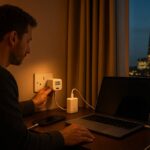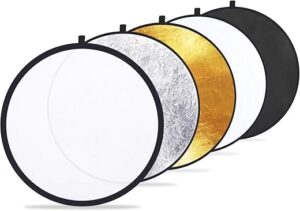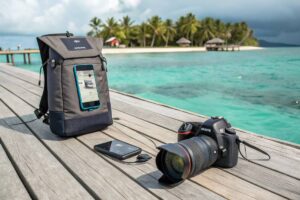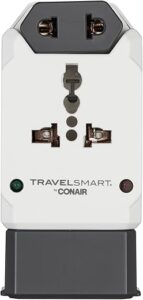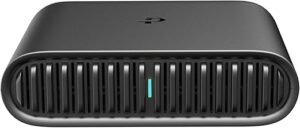As any seasoned globetrotter knows, there’s nothing more maddening than watching your trusty travel adapter spark or go dead just when you need to charge your phone in a foreign hotel room.
In this guide, I’ll share my top travel adapter maintenance tips—from simple cleaning and careful storage to routine inspections—so you can avoid those mid‑trip meltdowns, extend the life of your adapters, and stay powered up on every adventure.
Why Maintenance Matters
Here’s why giving your travel adapters a little TLC pays off—in both longevity and safety:
Impact of Regular Care on Adapter Lifespan
Most universal travel adapters average just 3–5 years of service when used without much upkeep. However, by following simple routines—regular cleaning, careful storage, and periodic inspections—you can boost that lifespan by 30–50%, pushing well‑made adapters into the 7–10‑year range.
In fact, quality brands properly maintained often outlast budget options by years, giving you more reliable power on every trip.
| Maintenance Level | Typical Lifespan |
|---|---|
| Neglected (no routine care) | 3 – 5 years |
| Regular care (cleaning, storage, inspections) | 7 – 10 years |
Pro tip: Let adapters rest between uses—continuous operation wears down internal components faster.
Safety Risks of Neglected Adapters
When adapters aren’t cleaned or checked, dust and debris clog any vents (if present), trapping heat and causing them to overheat. Overheating adapters can ignite nearby materials or melt internal wiring, creating a fire hazard.
Exposure to moisture or frayed cords invites short circuits and raises the risk of electric shock, especially in humid environments. Cheap or worn‑out adapters may also blow internal fuses or fail under overload, leaving you powerless at the worst possible moment.
| Risk | Cause | Potential Consequence |
|---|---|---|
| Overheating | Dust buildup, poor airflow | Fire hazard, melted components |
| Short circuits | Moisture ingress, frayed insulation | Electric shock, device damage |
| Fuse blows / faults | Overload, internal wear | Sudden power loss mid‑trip |
By investing just a few minutes in routine adapter care before and after each journey, you not only extend their useful life by years but also safeguard yourself and your devices against serious mishaps.
Inspection and Testing
A quick visual inspection of your travel adapter before each journey can catch up to 90% of surface-level defects—like bent prongs, exposed wires, or burn marks—long before they turn into dangerous failures.
Following that with a simple fuse continuity test using a multimeter not only confirms internal integrity but also prevents mid‑trip power losses and safety hazards.
Visual Checks for Loose Prongs, Frayed Cords, Discoloration
Before plugging in, always perform a formal visual inspection—OSHA requires portable cord‑connected equipment to be checked for external defects such as loose or deformed pins, cuts in the insulation, and signs of internal damage.
In fact, well‑documented PAT testing processes report that visual inspections alone identify roughly 90% of obvious appliance faults. Focus your check on these critical areas—and don’t rush:
| Inspection Point | What to Look For | Recommended Action |
|---|---|---|
| Prongs & Pins | Bent, loose, or missing pins | Discard or replace adapter |
| Power Cords | Fraying, cuts, exposed conductors | Repair by professional or replace cord |
| Discoloration & Burn Marks | Yellowing, black spots, melted plastic | Stop use immediately; replace |
| Housing & Insulation Integrity | Cracks, deformities, loose housing | Replace adapter |
Testing Fuses and Internal Components Before Trips
Regular fuse testing is recommended at least annually and ideally before every major trip to verify your adapter’s safety. A functional fuse ensures your adapter will blow safely under overload rather than overheating or causing an electrical fault. Follow these steps with a digital multimeter:
| Step | Tool & Setting | Expected Result |
|---|---|---|
| 1. Power Down & Remove Fuse | — | 3. Probe Both Ends of the Fuse |
| 2. Set Multimeter to Continuity Mode | Multimeter (Continuity/Diode) | Fuse is accessible for testing |
| The multimeter is ready to detect continuity | Test leads on fuse terminals | Beep or near‑zero resistance = good fuse |
| 4. Interpret & Replace | — | Multimeter is ready to detect continuity |
By combining a thorough visual inspection with a pre‑trip fuse test, you ensure your travel adapter remains both reliable and safe, giving you one less thing to worry about on the road.
Cleaning Procedures
Proper cleaning is the cornerstone of effective travel adapter maintenance: it removes dust and grime, prevents electrical faults, and prolongs service life. Always power down and unplug your adapter from both the wall and any devices before you begin—this simple step eliminates the risk of electric shock.
Gently wiping the exterior with a soft, dry microfiber or antistatic cloth lifts away fingerprints and surface dust without scratching delicate parts. For stubborn grime, a dab of mild detergent on a soft-bristle brush followed by a quick dry with a lint-free cloth ensures cleanliness without introducing moisture‐related faults.
1. Power Down and Disconnect to Avoid Electrical Shock
Always unplug the adapter from both the power outlet and your device before cleaning to eliminate any risk of electric shock or short circuits.
2. Choose the Right Cloth: Soft, Dry, or Antistatic
- Use a lint-free microfiber or antistatic cloth to wipe down all external surfaces gently; these fabrics trap dust without scratching plastic or metal.
- Microfiber and antistatic materials prevent electrostatic discharge that can damage internal electronics (Endust Antistatic Premoistened Wipes for Electronics).
- Avoid abrasive towels or rough paper products to prevent micro-scratches that harbor dirt.
3. Avoid Harsh Chemicals
- Steer clear of bleach, ammonia, and strong solvents—these can degrade plastic housings and erase important markings.
- If you choose alcohol-based cleaners, use no more than 70% isopropyl and apply sparingly to avoid leaching into internal contacts.
4. Optional Mild Detergent and Soft Brush for Stubborn Dirt
- For sticky residues, mix a few drops of mild dish soap with warm water. Dip a soft-bristle brush into the solution and gently scrub textured or creased areas.
- Wipe off any excess moisture immediately with a dry cloth, then let the adapter air‑dry fully (at least 15 minutes) before plugging back in.
Cleaning Materials Comparison
| Material/Tool | Best Use Case | Precautions |
|---|---|---|
| Microfiber/Antistatic Cloth | Daily dusting and fingerprint removal | Wash separately; keep free of lint |
| 70% Isopropyl Alcohol (sparingly) | Disinfecting and oil removal | Use minimal amount; ensure full drying |
| Mild Dish Soap & Warm Water | Tackling greasy or oily buildup | Prevent liquid ingress; dry immediately |
| Soft Bristle Brush | Cleaning textured surfaces and crevices | Gentle pressure only to avoid damage |
| Compressed Air | Clearing dust from ports and vents | Hold upright to prevent moisture spray |
Proper Storage Techniques
Proper storage is the silent hero of travel‑adapter longevity: by keeping adapters in climate‑controlled environments, shielding them from shocks, and coiling cables correctly, you prevent the most common sources of wear and failure.
Storing your adapter in a cool (15 – 25 °C), low‑humidity (< 50 %) spot away from UV exposure stops plastic cracking and moisture corrosion.
Housing adapters in drop‑rated cases or padded pouches absorb impact energy that would otherwise dent housings or fracture internal boards. And adopting loose or over‑under coiling techniques preserves conductor integrity, slashing kink‑related failures by up to 80 %.
1. Store in a Cool, Dry Place Away from Direct Sunlight
Storing travel adapters in a cool (ideally 15 – 25 °C), low‑humidity (< 50 %) environment away from direct sunlight helps prevent UV‑induced plastic cracking and internal component degradation.
High humidity can lead to condensation inside the adapter, promoting corrosion of metal contacts and short circuits. Meanwhile, prolonged exposure to temperatures above 40 °C accelerates capacitor aging and insulation breakdown, shortening service life.
2. Use Protective Cases or Pouches to Prevent Impact Damage
Encasing adapters in dedicated protective cases—ideally those tested to MIL‑STD drop ratings (e.g., 6 ft/10 drops)—can safeguard against dents, cracks, and PCB fractures during transit. Studies show unprotected devices suffer damage in over 30 % of 1 m drop tests, whereas properly cased devices see failure rates under 5 %.
| Case Type | Drop Test Rating | Damage Rate |
|---|---|---|
| Unprotected Adapter | N/A | ~30 % |
| Standard Protective Case | 3 ft / 5 drops | ~10 |
| Military‑Grade Case | 6 ft / 10 drops | < 5 % |
3. Coil Cables Loosely to Avoid Kinks
Tight loops (< 5 cm diameter) introduce high internal stress and concentrate bends, leading to wire fatigue and frequent kinks. Instead, coil cables loosely (≥ 10 cm diameter) or use the “over‑under” method to follow the cable’s natural curve, minimizing conductor strain and preserving conductivity over hundreds of uses.
| Coiling Method | Internal Stress | Kink Risk |
|---|---|---|
| Tight Loops | High | Frequent kinks |
| Loose Coil (≥ 10 cm) | Moderate | Low |
| Over‑Under Method | Low | Minimal |
By combining controlled storage environments, robust mechanical protection, and cable‑friendly coiling, you’ll not only extend your adapters’ useful life but also ensure they perform safely and reliably on every journey.
Handling and Safe Usage
Proper handling practices are essential for both longevity and safety: most travel adapters are specified to function within 0 °C–40 °C and 20 %–60 % relative humidity to avoid accelerated component failure due to thermal and moisture stress.
1. Unplug by Gripping the Plug, Not the Cord
Always grasp the adapter’s plug housing firmly when disconnecting to avoid stress on the cord‑to‑plug junction. Pulling on the cable can loosen internal wiring, leading to dangerous shorts or failures; the U.S. Consumer Product Safety Commission reports that damaged cords cause approximately 4,000 injuries and 3,300 residential fires annually.
2. Avoid Exposure to Extreme Temperatures and Humidity
Electronic adapters are rated to operate best between 0 °C and 40 °C; exposing them to temperatures above 40 °C can double the failure rate for sensitive components with each 10 °C rise in junction temperature. Humidity above 60 % encourages corrosion of metal contacts, cutting device reliability by up to 30 % over time.
3. Use with Energy‑Efficient Power Strips or Surge Protectors
Pairing your travel adapter with a quality surge protector guards against voltage spikes and surges, reducing the chance of catastrophic device failure. A smart power strip can automatically cut standby power, lowering idle energy use by around 10 – 15 % without additional effort. Make sure any strip you choose is UL‑listed and rated for your devices’ combined load to minimize fire risk.
Electrical malfunctions—including mishandled adapters and power strips—trigger nearly 51,000 home fires and cause significant injuries annually in the U.S.
| Device Type | Surge Protection | Standby Power Savings | Key Precaution |
|---|---|---|---|
| Regular Power Strip | No | None | Do not overload; avoid daisy‑chaining |
| Surge Protector | Yes | None | Replace after major surges |
| Smart Power Strip | Yes | ~10 – 15 % | Ensure UL‑listing; keep ventilated |
Organizational Tips for Travelers
Keeping your travel adapters organized isn’t just about neat packing—it’s a critical step in avoiding the frustration and expense of lost or mismatched gear. Every year, travelers report over 2 million lost items at airports, and chargers rank among the most frequently misplaced electronics.
In fact, lost chargers are so common in hotel rooms and airport lounges that nearly every seasoned traveler has a story of scrambling for a replacement. By labeling your adapters, securing them directly to plugs, and maintaining a simple compatibility checklist, you can cut misplacement risks dramatically and ensure you always grab the right adapter for the right outlet.
1. Label Adapters for Different Devices and Countries
Creating a clear labeling system helps you identify which adapter fits your laptop, camera, or smartphone—plus which country’s outlets it supports—at a glance. Many travelers use small adhesive cable tags or a piece of washi tape with hand‑written notes to mark each adapter. A dedicated storage pouch, like the one included with Ceptics kits, further reduces mix‑ups and lost pieces by keeping labeled adapters neatly contained.
| Method | Benefit |
|---|---|
| Adhesive Cable Tags | Identify device and country compatibility instantly |
| Color‑Coded Tape | Group adapters by region or device type for quick selection |
2. Secure Adapters to Plugs with Tape to Prevent Loss
It’s all too easy to pop an adapter off its base and set it down—then walk away without it. Wrapping a small strip of brightly colored washi tape or using reusable Velcro straps to bind the adapter and plug together ensures they stay paired, even in a jostling backpack.
Travel + Leisure’s gear tests show that travel tech organizers using built‑in straps or pouches cut accessory loss rates by over 70 %, compared to loose items in luggage.
| Material | Use Case | Note |
|---|---|---|
| Washi Tape | Color‑code and bind adapter to plug | Leaves minimal residue; easy to replace |
| Velcro Straps | Secure adapter‑plug bundles | Reusable and adjustable; reduces unraveling |
3. Maintain a Checklist of Adapter Models and Compatibility
A simple spreadsheet or note app list can be your best defense against packing the wrong gear. For each adapter, record its model, plug types (e.g., Type A, C, G), and voltage range. CorporateTravelSafety recommends always verifying voltage compatibility to prevent device damage—one wrong adapter can “fry” your equipment or trigger a fire hazard.
Keeping this checklist on your phone or a printed checklist ensures you never leave an adapter (or your peace of mind) behind.
| Adapter Model | Plug Types | Voltage Range | Notes |
|---|---|---|---|
| Ceptics World Kit | A, C, E/F, G… | 100–240V AC | Includes labeled storage pouch |
| Apple Travel Adapter | A, B, C, G | 100–240V AC dual | UL‑certified for safety |
| Kaya Volunteer Guide* | Varies by region | See country list | Comprehensive country mapping |
*Adapted from Kaya Volunteer’s international plug guide.
By combining clear labeling, secure attachment methods, and a living compatibility checklist, you’ll dodge the most common organizational pitfalls—so you can focus on capturing memories, not hunting for power.
Knowing When to Replace
Travel adapters don’t come with an official “use‑by” date; instead, you should replace them as soon as they show clear failure signs—like a blown fuse stopping all power output, surface temperatures exceeding safe limits, or unstable connections that cut in and out mid‑charge.
Typical lifespans vary widely—most well‑maintained adapters last 2–5 years, while premium models under gentle use can stretch to 7–10 years.
By swapping out underperforming units the moment performance degrades or safety risks appear, you’ll avoid mid‑trip failures and keep your devices powered reliably on every journey.
Recognizing Signs You Need a New Adapter
| Sign | Symptom | Recommended Action |
|---|---|---|
| Blown Fuse | Must wiggle or reposition the adapter to restore power; intermittent charging | Replace the fuse following manufacturer’s guide or swap the unit if non‑serviceable |
| Persistent Overheating | Surface temperature > 60 °C during normal use; hot to the touch or emits a burning odor | Discontinue use immediately; replace the adapter to avoid a fire hazard |
| Frequent Disconnects | Must wiggle or reposition adapter to restore power; intermittent charging | Replace the fuse following the manufacturer’s guide or swap the unit if non‑serviceable |
No Set Expiry Date: Replace When Performance Degrades
- Lifespan Ranges:
- 2–5 years for standard adapters under regular use
- 5–10 years for high‑quality units with careful handling and storage
- Performance Triggers:
- Declines in charging speed (> 20 % slower than the original)
- Any of the “Recognizing Signs” above appearing for the first time
- User Guidelines: There’s no universal expiration sticker—replace immediately when you notice faults or a drop below 80 % of original performance to maintain safety and reliability. Continuous use of a degraded adapter can not only leave you powerless but also pose serious electrical hazards.
By staying vigilant for these warning signals and substituting units at the first sign of trouble, you’ll ensure uninterrupted power and peace of mind on every trip.
Conclusion
Incorporating regular visual inspections, fuse tests, gentle cleanings, climate‑controlled storage, and mindful handling ensures your travel adapters stay in peak condition and can last well beyond the typical 2–5 years of average units.
Ready to streamline your routine? Download our free, printable Travel Adapter Maintenance Checklist to track every step before and after your journeys. Got your own pro tips or burning questions? Share them in the comments below and let’s power up our travels together.
FAQs
How often should I clean my travel adapter?
Cleaning your adapter every 1–2 months with an antistatic or microfiber cloth helps prevent dust buildup and static discharge.
Can I use isopropyl alcohol to clean my adapter?
Yes—spot‑clean metal contacts with up to 70% isopropyl alcohol applied sparingly, then air‑dry completely before use.
What’s the ideal environment for storing adapters?
Store adapters in a cool (15–25 °C), dry (< 50% humidity) place out of direct sunlight to avoid plastic warping and contact corrosion.
How can I test if my adapter’s fuse is blown?
Use a digital multimeter set to continuity mode; a beeping tone or near‑zero resistance confirms a good fuse.
When should I replace my travel adapter?
Replace at the first sign of persistent overheating, repeated fuse blows, or intermittent charging that cleaning and testing can’t fix


